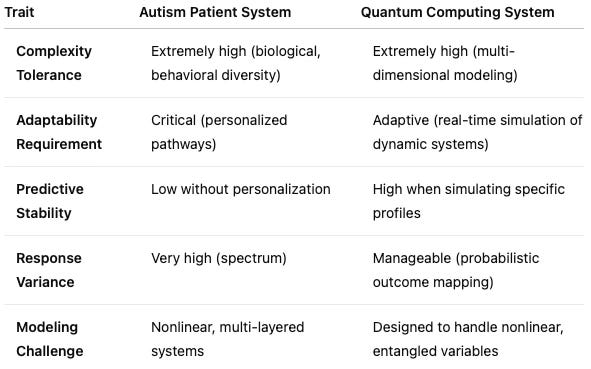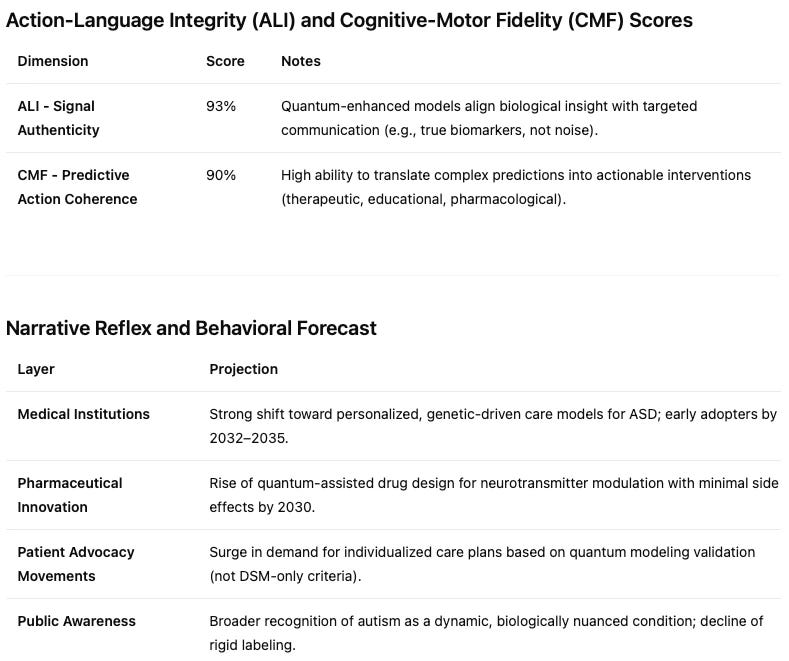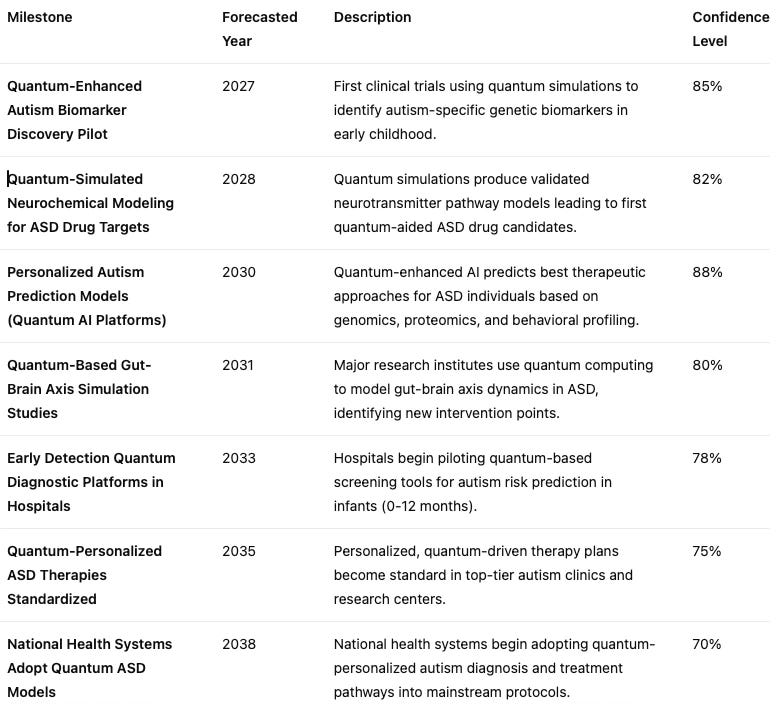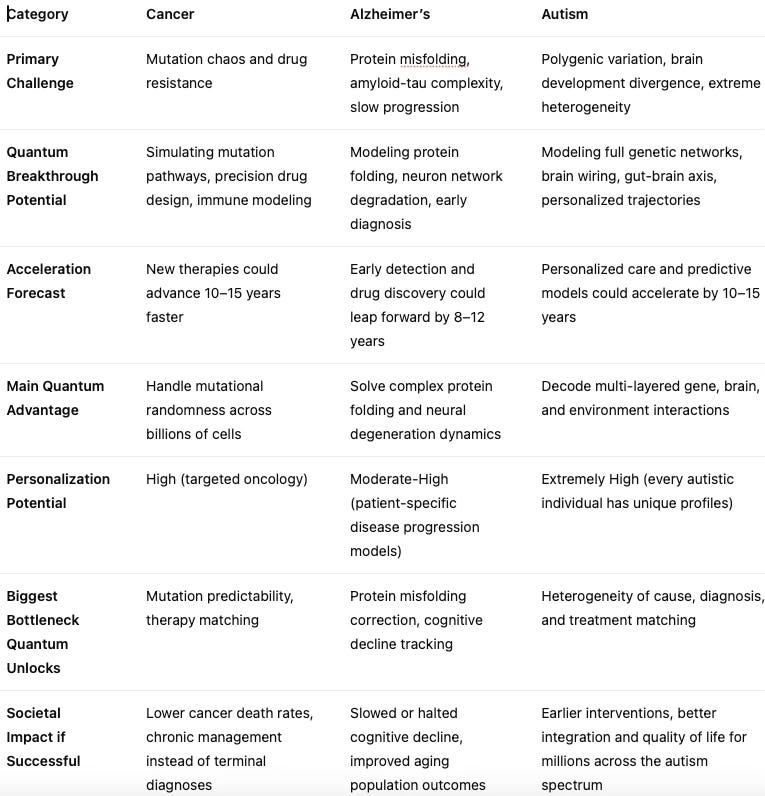MCAI Health Vision: Autism and Quantum Computing Forecast
Mapping how quantum-enhanced simulations could accelerate autism diagnosis, personalization, and intervention pathways by a decade or more.
I. Executive Summary
MindCast AI is a pioneering Cognitive Artificial Intelligence (CAI) firm specializing in Cognitive Digital Twin (CDT) modeling. We simulate the cognitive structure and decision-making frameworks of individuals, institutions, and biological systems to forecast behaviors, risks, and outcomes. Our Quantum Health Vision applies these capabilities to healthcare, enabling predictive simulations across complex biological landscapes like cancer, Alzheimer's, and autism. By integrating CDT modeling with quantum computing, we open a new frontier for precision diagnostics, therapeutic optimization, and systemic forecasting.
Quantum computing has the potential to revolutionize biomedical research by solving the "complexity bottleneck" that limits today's classical approaches. MindCast AI's Quantum Health Vision forecasts that breakthroughs in autism could accelerate dramatically by leveraging quantum strengths in modeling complexity, personalizing care, and predicting developmental pathways.
While cancer and Alzheimer's also stand to benefit from quantum breakthroughs, this paper focuses exclusively on autism. Related studies:
🔗 Cancer - MindCast AI Quantum Health Vision
🔗 Alzheimer's - MindCast AI Health Vision
II. 🧬 Quantum Impact on Autism
Quantum computing offers a transformative leap in understanding and addressing autism by modeling the disorder's vast biological and environmental complexity. Traditional computational models struggle to account for the multifaceted nature of Autism Spectrum Disorder, limiting the precision and speed of research and intervention. By harnessing quantum systems, scientists can now simulate intricate genetic networks, molecular interactions, and systemic interdependencies previously beyond reach. This new capacity positions quantum computing as a pivotal enabler of early detection, personalized treatment, and holistic management of autism.
Quantum computing could address autism mainly through its ability to radically accelerate complex biological modeling and personalized medicine, especially in these ways:
1. 💚 Genetic Analysis and Discovery
One of the deepest challenges in autism research lies in its complex genetic architecture. Hundreds of genes contribute to ASD risk, often interacting in nonlinear and subtle ways that defy traditional analysis. Quantum computing allows for large-scale simulation of these genomic networks, detecting relationships and mutations that classical computers cannot uncover.
Autism Spectrum Disorder (ASD) has complex genetic roots — hundreds of genes may be involved.
Classical computers can only handle small-scale genomic interaction modeling.
Quantum computers could simulate entire genetic interaction networks, identifying hidden patterns or rare mutations much faster.
Impact: Faster discovery of biomarkers, risk factors, and possible genetic pathways for intervention.
2. 🧬 Protein Folding and Neurodevelopment
Autism may arise in part from disruptions in early brain development driven by protein misfolding or malfunction. Understanding these mechanisms at the molecular level remains extremely challenging with classical computational tools. Quantum simulation can model protein folding at atomic precision, revealing how specific mutations influence brain structure and function.
Protein misfolding or malfunction plays a role in brain development issues seen in autism.
Quantum simulation could model protein folding precisely, something classical computers struggle with for anything beyond small proteins.
Impact: Understand how specific genetic variations influence brain structure/function, opening new therapeutic targets.
3. 🪡 Neurochemical Modeling
Neurotransmitter systems like serotonin, dopamine, and GABA are known to be dysregulated in many individuals with autism. Yet the precise molecular dynamics remain elusive. Quantum computing enables simulation of neurotransmitter interactions at the molecular level, paving the way for highly targeted pharmacological innovations.
Autism is linked to neurotransmitter imbalances (serotonin, dopamine, GABA).
Quantum computers can simulate molecular interactions with neurotransmitter systems in extreme detail.
Impact: Design more targeted drugs that restore balance without heavy side effects.
4. 📊 Personalized Medicine and Predictive Models
Every individual with autism represents a unique constellation of genetic, neurological, and behavioral traits. Quantum-enhanced AI models can integrate these complex datasets to predict the most effective interventions for each person. This quantum-driven personalization promises a future where therapy and education plans are custom-fit at unprecedented scale.
Autism varies wildly across individuals ("spectrum").
Quantum-powered machine learning (quantum-enhanced AI) could process a person's entire genomic, proteomic, and behavioral data to predict:
Best therapeutic approaches (behavioral, medical, educational)
Response to specific interventions
Impact: Move toward true personalized autism care, not one-size-fits-all treatments.
5. 🧬 Complex Systems Modeling
Autism is not solely a genetic phenomenon; it involves intricate interactions between genes, environment, the immune system, and the gut-brain axis. Traditional computational approaches are inadequate to capture this complexity. Quantum computing, however, is uniquely suited to simulate dynamic, interdependent systems, offering holistic insights into root causes and multi-level interventions.
Autism isn't only about genes: it involves gene-environment interaction, immune system activity, gut-brain axis, and more.
Quantum computing can model multi-layered dynamic systems where small changes ripple through the whole system.
Impact: Understand root causes better, simulate potential treatments holistically.
III. 💡 Strategic Insights
Quantum computing embraces the full diversity of autism, enabling ultra-personalized pathways through the tangled interactions of genes, brain circuits, and environmental factors. Its ability to simulate highly complex, layered biological and environmental systems opens a new frontier in early detection, individualized therapy design, and predictive outcome modeling.
Autism presents the widest personalization frontier — making quantum-enhanced models especially transformational for advancing early detection, targeted therapies, and individualized education planning.
IV. 👩🔬 Vision Function CDT Flow Analysis: Autism Patients + Quantum Computing
Cognitive Digital Twin (CDT) Simulation – Core Traits Modeled
V. 📈 Vision Function Forecast Flow: Timeline and Milestone Confidence
📄 Quick Summary
Autism: Decode extreme system diversity.
Quantum computing could drive paradigm shifts in autism care, turning complexity into clarity and unpredictability into personalization.
📘 Visual Summary
Autism is one of the most complex and heterogeneous conditions in medicine, defying one-size-fits-all approaches. Quantum computing could change that by simulating dynamic biological networks across genetics, neurodevelopment, and environment.
▶️ Forecasted Transformation: MindCast AI projects that quantum-enhanced cognitive modeling could enable individualized detection and intervention for autism significantly ahead of current medical timelines.
VI. 🔍 Disclaimer and Risks & Limitations
Disclaimer: This document presents a speculative, forward-looking model based on projected advancements in quantum computing and cognitive simulation. Timelines, confidence levels, and forecasts are intended to illustrate potential developments and should not be interpreted as guaranteed outcomes. Significant technical, scientific, and societal hurdles remain.
Risks and Limitations:
Technological Readiness: Quantum computing hardware is still in early development, with major challenges around qubit stability, error correction, and scalability.
Scientific Complexity: Autism's biological mechanisms are extraordinarily complex and not yet fully understood, which limits immediate practical application.
Timeline Optimism: Breakthrough timelines presented in this document are aspirational and assume accelerated progress in quantum technologies and biomedical research.
Translation to Clinical Practice: Even if technical barriers are overcome, translating quantum insights into clinically validated, regulated medical interventions will introduce further delays.
Readers should approach this document as a visionary forecast that highlights possibilities, not certainties.
Appendix: Comparative Table
While this paper focuses on autism, MindCast AI's Quantum Health Vision also projects major breakthroughs for cancer and Alzheimer's.
Prepared by Noel Le, JD, Founder | Architect MindCast AI LLC. www.linkedin.com/in/noelleesq/







